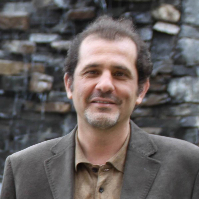Relating to pedestrian Route and Expressway; (Case study: Resalat expressway; The part joining Bayhaghi and Seyedkhandan terminal)
Author(s):
Abstract:
Due to recent urban developments, the undesireable presence of pedestrians along urban expressways for access to public transportation facilities, daily trips and evading traffic is a typical trend. This problem decreases the urban life quality and health of citizens in a metropolis like Tehran. New viewpoints consider this daily travel along "expressway landscapes" as a kind of "everyday nature". It is important to notice that, the meaning of everyday nature and what be perceived in everyday landscape are different form a park or sites with recreation, sports goals. Review of debates over "presence of pedestrians along expressways" shows the opposing views have reduced dramatically over time. This article addresses the quality of "pedestrian connections improvements" along expressways and their related aspects of programing and design. The research is based on the case study of Resalat expressway, as one of most important population core and transportation systems of Tehran. The question is can landscape architects use bridges, existing sidewalks, parallel pedestrian, green patch and other facilities to plan a "continuous pedestrian connection" where daily travel is requested? Does experiences like Tabiat bridge in Tehran or Highline in NewYork, which both are recreational places, have a role in development and improvement of such pedestrian connections as an everyday nature of cities?
The framework is based on "Forman model of landscape ecology" and "viewpoint of Kaplan about everyday nature"; through using case study/combined research strategy with synthesizing case procedure. After evidences review, phenomenon survey in the flowing steps. First is inspect and analysis of "quality-oriented approach of landscape", "landscape ecology of Forman", "Kaplans view point of everyday nature", definitions and principles of "pedestrian and expressway design". Second is study of real cases and acquire essential needs for design research through the production and use of a template module of analysis which is generated from the previous step. Third is case study area Pathology and quality of related improvement identifying. This step also uses the previous step structure of template module of analysis. Final step present the findings and Indicators to identify demands for improvement (table5) and some standard offer for this kind of design (table6), which can be generalized to similar problems in other situations (transferability).
Findings associated with proponents of "pedestrian presence along expressways", conditionally consider "pedestrian connecting" along expressways as an opportunity. Its important to consider this kind of request for commuters as a real aspect of today cities. This phenomenon can be "ignored", "prohibited" or "improved as an opportunity". Last approach have a holistic theory to balance the needs of city with new conditions to achieve higher quality of everyday urban life.
The framework is based on "Forman model of landscape ecology" and "viewpoint of Kaplan about everyday nature"; through using case study/combined research strategy with synthesizing case procedure. After evidences review, phenomenon survey in the flowing steps. First is inspect and analysis of "quality-oriented approach of landscape", "landscape ecology of Forman", "Kaplans view point of everyday nature", definitions and principles of "pedestrian and expressway design". Second is study of real cases and acquire essential needs for design research through the production and use of a template module of analysis which is generated from the previous step. Third is case study area Pathology and quality of related improvement identifying. This step also uses the previous step structure of template module of analysis. Final step present the findings and Indicators to identify demands for improvement (table5) and some standard offer for this kind of design (table6), which can be generalized to similar problems in other situations (transferability).
Findings associated with proponents of "pedestrian presence along expressways", conditionally consider "pedestrian connecting" along expressways as an opportunity. Its important to consider this kind of request for commuters as a real aspect of today cities. This phenomenon can be "ignored", "prohibited" or "improved as an opportunity". Last approach have a holistic theory to balance the needs of city with new conditions to achieve higher quality of everyday urban life.
Keywords:
Language:
English
Published:
Bagh-e Nazar, Volume:13 Issue: 39, 2016
Pages:
5 to 24
https://magiran.com/p1539886
مقالات دیگری از این نویسنده (گان)
-
Rural Landscape: A Systematic Review of Thematic Contexts
Mojgan Ghorbanzadeh, *, Saeid Norouzian-Maleki
Journal of Architecture and Urban Planning,



